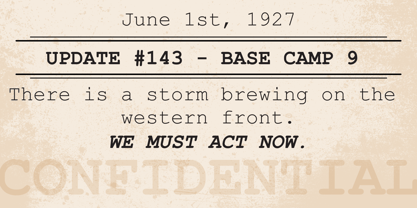Wählen Sie diesen Lizenztyp, wenn Sie eine app für iOS, Android oder Windows Phone entwickeln und Sie die Datei Font in den Code Ihrer mobilen Anwendung einbetten.
Courier New OS
von Monotype
- Aa Glyphen
-
Bestes AngebotFamilienpakete
- Einzelschnitte
- Technische Daten
- Lizenzierung
Per Font:
$33.99
Paket mit 4 Fonts:
$135.99
Über die Schriftfamilie Courier New OS
Die Courier New wurde als Schreibmaschinenschrift für IBM entworfen und von Adrian Frutiger für die IBM Selectric-Serie neu gezeichnet. Ein typisches Design mit festem Pitch, monoton im Gewicht und Slab Serif im Konzept.
Designer:
Herausgeber: Monotype
Foundry: Monotype
Eigentümer des Designs: Monotype
MyFonts Debüt: Dezember 12, 2001

Über Monotype
Die Monotype Library ist eine der weltweit größten und umfangreichsten Sammlungen von Schriften mit Originaldesigns von historischer Bedeutung und einer neuen Auswahl an modernen und modischen Fonts. Die Monotype Library umfasst Tausende von zeitlosen Klassikern, handgefertigten Neuauflagen und Originaldesigns von vielen der innovativsten Schriften Designer und Foundrys der Geschichte. Diese unverwechselbare, preisgekrönte Bibliothek der Premium Fonts bietet Marken und Designer eine breite und zuverlässige Auswahl an Schriften für ausdrucksstarke Typografie im Druck und auf dem Bildschirm. Die Seite Premium Foundry kann hier eingesehen werden.
Mehr lesen
Weniger lesen